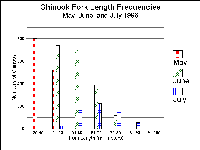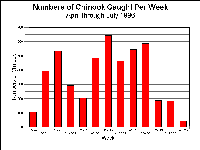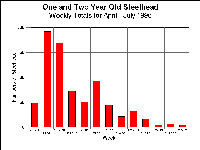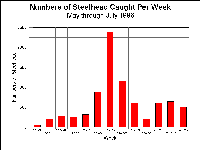| Area | Lower Trinity/Basin-wide |
| Topic | Fish: Horse Linto Cr Downstream Trap Results 1996 |
The length frequency of Chinook salmon by week in 1996 at the Horse Linto Creek trap is similar to results from 1994 but with some variation. Trapping started later in 1996 due to high flows and Chinook fry in May were smaller with the average length centered around 40 mm while the May 1994 average length of Chinook fry was 50-60 mm. The length increased in June 1994 to an average of 60-70 mm and 1996 results show an average length of 50-60 mm for the same period. Higher flows were likely a product of high snow melt and resulting cold, high flows may have produced slower growth. However, varying trap efficiencies with higher flows can also lead to anomalies. The largest migrant Chinook captured in 1996 was less than 90 mm. The Lower Trinity Ranger District, Six Rivers National Forest, provided the graph above in an Excel spreadsheet. See Info Links for more information.
The chart above comes from a Six Rivers National Forest Excel spreadsheet and shows the number of Chinook juvenile downstream migrants captured at the Horse Linto downstream migrant trap from May to July 1996. Trapping typically starts in April but flows were too high in 1996. The trap results show a much more extended peak of migration in 1996 than in 1994 when May had the highest capture. The smaller size of Chinook in 1996 as shown in the chart captured as Picture #1 was likely related to the later migration peak. See Info Links for more information.
Older age juvenile steelhead caught in the Horse Linto Creek downstream migrant trap were most numerous early in the trapping season and showed a gradual decline until the end of trap operation in July. This seems to vary somewhat from 1994 results when almost no older age steelhead migrated in June. No trapping took place in April 1996 because of high flows and 1994 trap results show a high catch of older juvenile steelhead in that month. Chart above taken from Six Rivers National Forest spreadsheet. See Info Links for more information.
The chart above was taken from a Six Rivers National Forest Excel spreadsheet and shows young of the year juvenile steelhead caught in the Horse Linto Creek downstream migrant trap in 1996. The pattern of immigration follows that of 1994 except that higher numbers of young steelhead were captured later in the season. High flows and cold water could have delayed hatching and slowed growth, which could then be linked to later out-migration. No trapping took place in April 1996 because of high flows but 1994 trap results showed few young of the year steelhead in that month. See Info Links for more information.
 Click on image to enlarge (18K).
Click on image to enlarge (18K). Click on image to enlarge (18K).
Click on image to enlarge (18K). Click on image to enlarge (18K).
Click on image to enlarge (18K). Click on image to enlarge (17K).
Click on image to enlarge (17K).
To learn more about this topic click Info Links
To view additional information (data source, aquisition date etc.) about this page, click Metadata
| www.krisweb.com |
